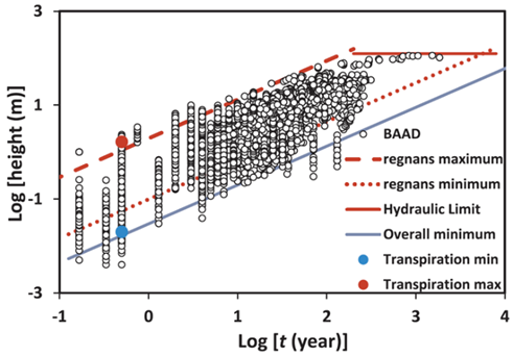The Science
Soil structure and topographic features explain within-species and local-scale variability in tree growth. Using percolation theory, it is shown that root growth into the surface soil layers (0–2 m) tends to follow paths with minima in resistance, which in turn maximizes water flow and nutrient delivery rates that regulate growth and transpiration rates.
The Impact
This analysis generates the hypothesis that within-species and local-scale variability in transpiration, and hence tree growth, can be reliably predicted by soil structure because root growth into the surface soil layer (0–2 m) tends to follow paths with minima in resistance, which in turn maximizes water flow and nutrient delivery rates. It is shown that the variability in tree height may be accounted for by a single analytical equation for the growth of plants, which is governed by the optimal root length within the radial extent of the roots in the surface soil layer.
Summary
It is well established that tree growth rates are proportional to transpiration rates. This study investigates whether variability in tree growth on local scales and within species is related to constraints placed on transpiration by soil structure and other environmental conditions and not by constraints related to available soil water. Percolation theory is applied to explain how root-soil interactions regulate transpiration where root growth into the surface soil layer (0–2 m) tends to follow paths with minima in resistance, which in turn maximizes water flow and nutrient delivery rates that regulate growth. It is shown that the variability in tree height may be accounted for by a single analytical equation for the growth of plants, which is governed by the optimal root length within the radial extent of the roots in the surface soil layer. The scientific results are based on testing several scenarios of different topographic features (curvature, slope, and aspect), soil characteristics, and climate ranges. The results can be used for analytical calculations of NPP within the scope of the NGEE-Tropics project.

Contacts (BER PM): Daniel Stover, SC-23.1, Daniel.Stover@science.doe.gov (301-903-0289)
PI Contact: Boris Faybishenko, Lawrence Berkeley National Laboratory, bafaybishenko@lbl.gov
Funding
This research was partially supported by the NGEE-Tropics and DEDUCE projects, funded by the U.S. Department of Energy, Office of Science, Office of Biological and Environmental Research, and Office of Advanced Scientific Computing under contract DE-AC02–05CH11231.
Publications
Hunt AG, Faybishenko B, Powell TL (2020) A new phenomenological model to describe root-soil Interactions based on percolation theory. Ecological Modelling. doi: 10.1016/j.ecolmodel.2020.109205.